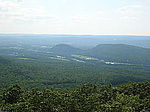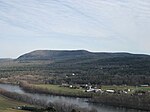Buttonball Tree

The Buttonball Tree is an exceptionally large American sycamore (Platanus occidentalis) located in Sunderland, Massachusetts. Though the nickname "buttonball" has been used for all like trees, this tree retained the name, mainly because of its pure size and popularity. As of November 2019, the tree is over 113 ft (34 m) high, with a girth of 25 ft 8 in (8 m) (at 4.5 ft (1.37 m) high) and a spread of 140 ft (43 m). It is a remnant of Sunderland's forests. Because of their longevity, during the 17th and 18th century sycamores were sometimes planted at the door of new houses for newlyweds as "bride and groom" trees. Though the age of the tree is unknown, it is estimated to be well over 350 years old, with many estimates saying that the tree is closer to 400. The tree is well known and is one of the larger tourist attractions of the town. The tree is believed to be the largest tree of its kind on the East Coast, or as locals put it, "The widest tree this side of the Mississippi."
Excerpt from the Wikipedia article Buttonball Tree (License: CC BY-SA 3.0, Authors, Images).Buttonball Tree
North Main Street,
Geographical coordinates (GPS) Address External links Nearby Places Show on map
Geographical coordinates (GPS)
| Latitude | Longitude |
|---|---|
| N 42.468841666667 ° | E -72.578372222222 ° |
Address
Sycamore (Buttonball) Tree
North Main Street
01375
Massachusetts, United States
Open on Google Maps








